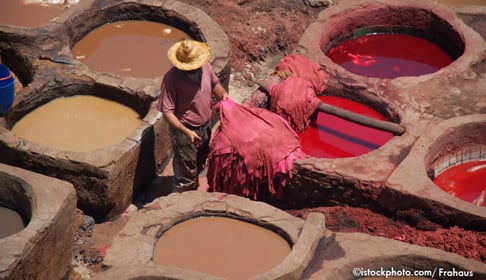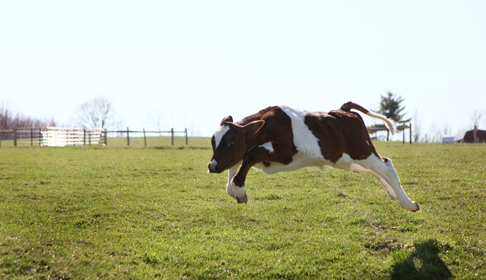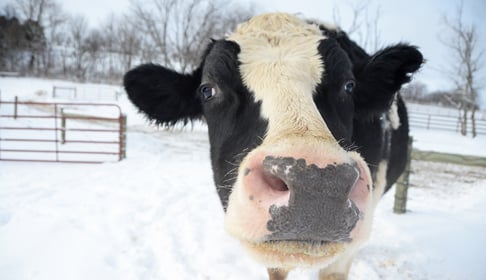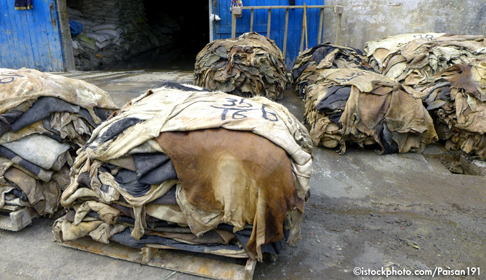By Bruce Friedrich, Director of Policy and Advocacy
A couple years ago, The New York Times Magazine ran a glowing cover profile of fashion designer Stella McCartney. The piece focused on how down to earth she is and how incredibly hard she works, but I was particularly interested in the sympathetic coverage of Stella’s animal rights activism and her refusal to use leather.
The successful designer reasons that, “Using leather to make a handbag is cruel. But it’s also not modern; you’re not pushing innovation.”
I suspect that this comment took many readers by surprise. Most people don’t realize how horrible leather is for the environment or that it’s devastating for tannery workers, nearby communities, and animals.

As I read the article, I was reminded of Joe Wilson’s and Valerie Plame’s appearance on Real Time with Bill Maher when the couple was promoting Plame’s book. During the segment, Maher gives Wilson a hard time for appearing on his show wearing a leather jacket. His response to seeing Wilson in leather is not surprising because Maher is vocal about his support for animal rights. Watching it, I was impressed that Maher, who is clearly supportive of the couple and respects them, was nonetheless candid about his disagreement with Wilson’s choice, pointing out that leather supports egregious cruelty to animals.
Farm Sanctuary has been providing lifelong care to cows and other farm animals for nearly three decades, and we can tell you from experience that cows are interesting individuals. They each have distinct personalities that range from playful to reserved. They form strong, loving bonds. Every day, we see that cows share the same qualities people admire in the dogs and cats millions welcome into their homes.

Michael running free at our New York Shelter.
And science validates our experiences. Cows interact with one another in complex and collaborative ways. They learn from each other and make decisions based on altruism and compassion. They even form “grooming partnerships,” just like chimpanzees. The Sunday Times (UK) science editor Jonathan Leake explains that “cows have a secret mental life in which they bear grudges, nurture friendships, and become excited over intellectual challenges.” There’s much more, too, which we’ve distilled on the Someone, Not Something pages of our website.
Jane Goodall explains that “farm animals feel pleasure and sadness, excitement and resentment, depression, fear, and pain. They are far more aware and intelligent than we ever imagined … they are individuals in their own right.” For these reasons, Farm Sanctuary values all life. We would no more kill and wear a cow than we would a kitten or a puppy. And my guess is that people who wear leather can’t come up with a convincing explanation as to why these animals should be treated differently.

The sweet and curious Jay.
Besides dying for leather, cows in industry are abused throughout their short lives. Their bodies are mutilated without pain relief, they’re fed a diet that keeps them in chronic pain, and they’re transported for days at a time through all weather extremes. That’s just what happens in the United States. In China and the developing world, where most animal skins originate, the abuse of cows exceeds our worst nightmares.
Animals aren’t the only ones who suffer to produce leather. What most consumers don’t know is that even if a leather garment is expensive and made in the United States or Europe, the actual leather is probably still cheaply produced in China or the developing world.

In order to stop a cow’s skin from decomposing as it would naturally, it is treated with highly toxic chemicals, turning it into something that defies nature: an animal’s corpse that will never rot. These chemicals are horrible for the environment, for the workers in the tanneries, and for the populations living downstream. In the New Scientist, a lawyer for China’s Centre for Legal Assistance to Pollution Victims describes conditions on one river poisoned by waste from a nearby tannery: “A few years ago, villagers could swim in the river. Now they get blisters on their hands and feet from touching the water. … When you stand close to the river you can smell rotting flesh because the leather factory dumps its sewage, made up of animal skin and meat, untreated into the river.” Is a leather jacket, belt, or pair of shoes really worth that?
This PETA investigation video, narrated by Stella McCartney, shows what animals and workers suffer for leather (this video contains graphic images):
Every time we choose what we’re going to wear, we’re also sending a message about who we are in the world. Wearing dead animals does not send a message of compassion. Instead, wearing leather carries a message of cruelty to animals and the poisoning of workers and communities. Who wants to be part of that?

I used to love going to IKEA to shop, progressive, etc., but while roaming the aisles, I came across a huge pile of cowhides for sale. I was disgusted!!! I can only imagine how many poor, poor animals were killed in order to sell these to what (?) put them on the floor in your home..EWWW. I think twice about shopping there now.
This is the first time I have see a picture of leather being tanned-the vats of chemical soaked blood are haunting. I applaud Stella McCartney for being a leader is the push for change in an industry that is so driven by human wants.
I think that we do not need to prove that cows are intelligent, social, emotional, caring etc, in order to validate their right to agency over their own lives. They deserve not to suffer at our hands, just because…….
Thank you for caring!-and for doing something about it.
This is a great article. Thank you so much for posting. We are conditioned by society to seek out only products made of “genuine” leather, as if that is a good thing– desirable, even– something that denotes quality and integrity in product design. How did we get so mixed up?
It’s going to take a lot to reverse this stigma and finally change the minds of people so brainwashed by society, but the truth about leather is worth it. We need more articles like this.